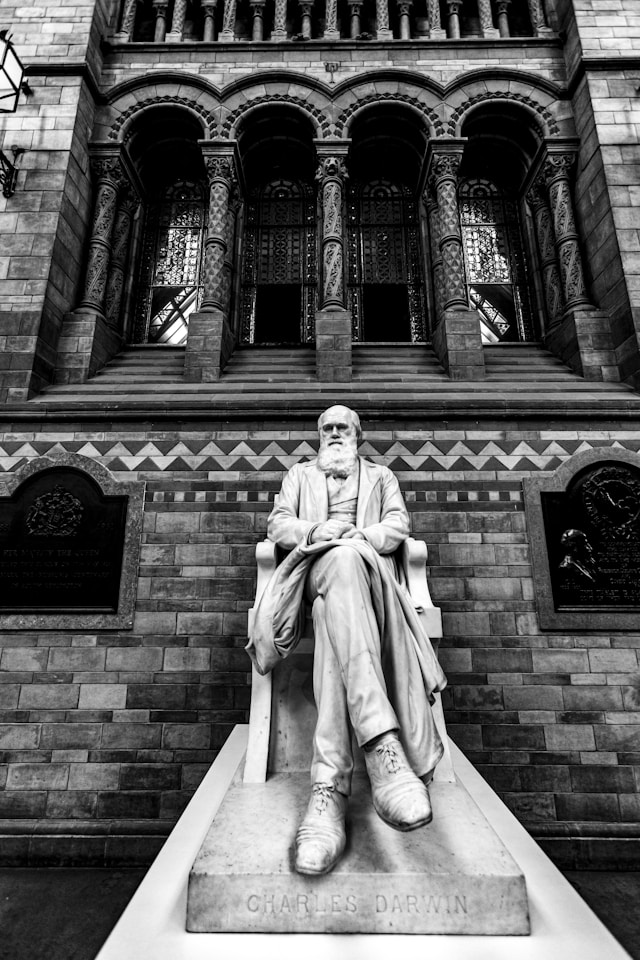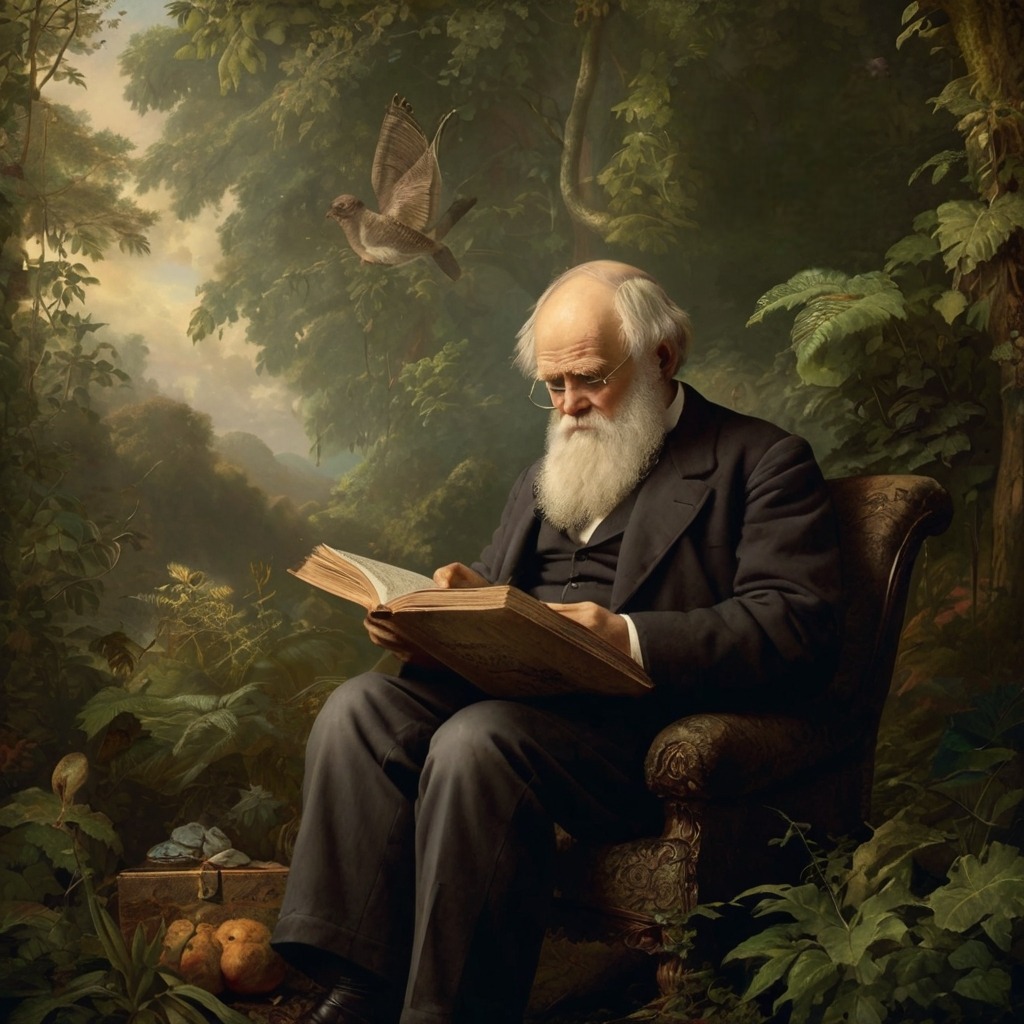The concept of evolution, the gradual development of life over time, has fascinated humans for centuries. Two influential perspectives on this subject come from Charles Darwin’s scientific observations and the ancient Hindu philosophy found in the Rigveda. While these sources are separated by millennia and cultural contexts, both offer profound insights into the nature of life and its origins. Darwin’s groundbreaking theory of natural selection and the Rigveda’s timeless wisdom provide complementary lenses through which to explore the mysteries of existence.
Darwin's Theory of Evolution
Charles Darwin’s theory of evolution by natural selection, introduced in his landmark book “On the Origin of Species” (1859), revolutionized our understanding of biological development. Darwin proposed that species evolve over time through a process of natural selection, where individuals with advantageous traits are more likely to survive and reproduce. This gradual process leads to the emergence of new species and the diversity of life observed today.

Key Points of Darwin's Theory:
- Natural Selection: The mechanism by which advantageous traits become more common in a population. Traits that improve an organism’s chances of survival and reproduction tend to become more prevalent in successive generations.
- Common Descent: The idea that all species share a common ancestor. Darwin’s famous illustration of the “tree of life” shows how different species diverge from common points of origin.
- Gradualism: Evolution occurs through small, incremental changes over long periods. This challenges the notion of species being fixed and immutable.
- Adaptation: The process by which organisms become better suited to their environments. Adaptations result from natural selection acting on genetic variation within populations.
- Fossil Record: Provides historical evidence of evolution. Fossils show a timeline of gradual change in species, supporting the theory of common descent.
Darwin’s theory is supported by extensive evidence from various scientific disciplines, including paleontology, genetics, and comparative anatomy. It emphasizes the role of environmental pressures and genetic variation in shaping the evolutionary process. The modern synthesis of evolutionary biology integrates Darwin’s ideas with genetic theory, further solidifying the scientific foundation of evolution.
Evolution in Hindu Philosophy: The Rigveda
The Rigveda, one of the oldest texts of Hinduism, presents a philosophical perspective on the origins and development of life. Unlike Darwin’s empirical approach, the Rigveda’s explanations are deeply rooted in spiritual and metaphysical concepts. The Rigveda does not detail a linear process of evolution but offers hymns and verses that reflect on creation and the cyclical nature of life.

Key Concepts from the Rigveda Relevant to Evolution:
- Cosmic Order (Rta): The fundamental order and harmony of the universe, governing the cycles of creation and destruction. Rta represents the natural order and laws that maintain balance in the cosmos.
- Purusha Sukta: A hymn describing the cosmic being, Purusha, whose sacrifice led to the creation of all life forms. This metaphorical narrative explains the diversity of life and the interconnectedness of all beings.
- Cyclic Time: The belief in recurring cycles of creation, preservation, and dissolution, known as Yugas. Each Yuga represents a different epoch in the cosmic cycle, emphasizing the eternal nature of the universe.
- Elements of Creation: The Rigveda speaks of the five elements (earth, water, fire, air, and ether) as fundamental components of life. These elements combine in various ways to create the diversity of life forms.
- Divine Will: Creation and evolution are seen as manifestations of divine will. Gods and cosmic forces play crucial roles in the unfolding of the universe.
In the Rigveda, the evolution of life is intertwined with cosmic principles and divine actions. It suggests a holistic and interconnected view of existence, where all forms of life are part of a grand, cyclical process governed by cosmic laws. This spiritual perspective complements the scientific explanation by offering a broader understanding of life’s origins and purpose.
Comparative Analysis
- Mechanism vs. Metaphor:
- Darwin: Evolution is driven by natural selection, a tangible and observable process. Natural selection operates through differential survival and reproduction of organisms based on their traits.
- Rigveda: Evolution is a part of the cosmic order, represented through metaphors and spiritual concepts. The Purusha Sukta, for instance, uses the metaphor of a cosmic being’s sacrifice to explain the creation of life, emphasizing the interconnectedness of all existence.
- Empirical Evidence vs. Spiritual Insight:
- Darwin: Relies on empirical evidence and scientific observation. Fossils, genetic studies, and observations of living organisms provide concrete data supporting evolution.
- Rigveda: Draws from spiritual insights and metaphysical reflections. The hymns and verses offer a philosophical and symbolic understanding of life’s evolution, focusing on the spiritual and moral dimensions.
- Linear vs. Cyclical:
- Darwin: Evolution is a linear, progressive process leading to increased complexity over time. This perspective views evolution as a historical timeline marked by branching points where species diverge.
- Rigveda: Evolution is cyclical, reflecting the perpetual cycles of creation and dissolution. This cyclical view, rooted in the concept of Yugas, suggests that life undergoes continuous renewal and transformation within the cosmic order.
- Individual vs. Universal Perspective:
- Darwin: Focuses on individual species and their adaptation to environments. The theory of evolution by natural selection highlights the role of individual organisms in the broader evolutionary process.
- Rigveda: Emphasizes the interconnectedness of all life within the universe. The Rigveda’s perspective is more holistic, considering the unity of all beings as part of a greater cosmic reality.
- Adaptation and Survival:
- Darwin: Adaptation is key to survival. Organisms with beneficial adaptations are more likely to survive and reproduce, passing on their traits to future generations.
- Rigveda: Adaptation is seen in the context of cosmic harmony. Life forms adapt within the framework of Rta, maintaining balance and order in the universe.
- Role of Deities:
- Darwin: No role for deities or supernatural beings. Evolution is explained through natural processes without invoking divine intervention.
- Rigveda: Deities play a crucial role in creation and evolution. The Rigveda attributes the unfolding of life to divine will and cosmic principles, integrating spirituality with the natural world.
- Ethical and Moral Considerations:
- Darwin: Evolutionary theory itself is neutral regarding ethics, but it has implications for understanding human behaviour and morality. It suggests that moral behaviours may have evolved because they offer survival advantages.
- Rigveda: Deeply ethical and moral, emphasizing dharma (righteousness) and karma (action). The Rigveda’s view of evolution incorporates ethical dimensions, suggesting that living in harmony with cosmic laws leads to spiritual growth and evolution.
- Human Place in Nature:
- Darwin: Humans are part of the natural world, sharing a common ancestry with other species. This perspective places humans within the continuum of life on Earth.
- Rigveda: Humans have a unique role within the cosmic order. The Rigveda sees humans as integral to the spiritual and moral fabric of the universe, with responsibilities towards maintaining balance and harmony.
While Darwin’s theory of evolution and the Rigveda’s philosophical musings on life differ in their approaches and contexts, both offer valuable perspectives on the nature of existence. Darwin provides a scientific framework for understanding the biological processes that drive evolution, emphasizing empirical evidence and natural mechanisms. In contrast, the Rigveda presents a spiritual and holistic view of life’s interconnectedness, emphasizing cosmic principles and divine will.
By exploring these diverse viewpoints, we can appreciate the multifaceted nature of the quest to understand our origins and the ongoing journey of evolution. Both Darwin’s theory and the Rigvedic philosophy contribute to a richer, more comprehensive understanding of life, each offering unique insights that reflect the depth and complexity of our existence. In a world that often seeks clear-cut answers, these perspectives remind us of the beauty and intricacy inherent in the story of life.



